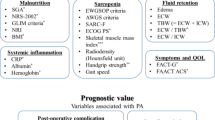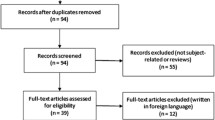Abstract
Purpose
Phase angle (PA), determined by bioelectrical impedance analysis (BIA), has been considered as a prognostic factor in several clinical conditions. The purpose of this study is to investigate PA, after adjusting for sex and age (standardized phase angle; SPA) as a prognostic factor for survival in cancer patients.
Methods
A prospective study was conducted in 195 patients before the first chemotherapy course. BIA was performed in all patients and SPA was calculated. The Kaplan-Meier method was used to calculate survival. The Cox regression method was used to evaluate the independent prognostic effect of PA after adjustment for other variables.
Results
Patients with SPA < −1.65 had a smaller survival rate than those with SPA ≥ −1.65 (p < 0.001). Using Cox regression, the mortality rate was higher in patients with SPA < −1.65 (RR 3.12 CI: 2.03–4.79; p < 0.001). After multivariate analysis, patients with PA < −1.65 still presented a higher mortality rate (RR 2.35 CI: 1.41–3.90; p = 0.001).
Conclusions
The present study demonstrates that PA, used as SPA, is an independent prognostic indicator in this group of cancer patients receiving chemotherapy treatment even after adjustment for other prognostic variables.

Similar content being viewed by others
References
Stratton RJ, Green CJ, Elia M (2003) Prevalence of disease-related malnutrition. In: Stratton RJ, Green CJ, Elia M (eds) Disease-related malnutrition: an evidence-based approach to treatment. CABI Publishing, Wallingford, pp 35–92
Ottery FD (1994) Cancer cachexia: prevention, early diagnosis and management. Cancer Pract 2:123–131
Gupta D, Lammersfeld CA, Burrows JL, Dahlk SL, Vashi PG, Grutsch JF, Hoffman S, Lis CG (2004) Bioelectrical impedance phase angle in clinical practice: implications for prognosis in advanced colorectal cancer. Am J Clin Nutr 80:1634–1638
Barbosa-Silva MC, Barros AJ, Post CL, Waitzberg DL, Heymsfield SB (2003) Can bioelectrical impedance analysis identify malnutrition in preoperative nutrition assessment? Nutrition 19:422–426
Chertow GM, Lowrie EG, Wilmore DW, Gonzalez J, Lew NL, Ling J, Leboff MS, Gottlieb MN, Huang W, Zebrowski B et al (1995) Nutritional assessment with bioelectrical impedance analysis in maintenance hemodialysis patients. J Am Soc Nephrol 6:75–81
Fein PA, Gundumalla G, Jorden A, Matza B, Chattopadhyay J, Avram MM (2002) Usefulness of bioelectrical impedance analysis in monitoring nutrition status and survival of peritoneal dialysis patients. Adv Perit Dial 18:195–199
Lukaski HC, Johnson PE, Bolonchuk WW, Lykken GI (1985) Assessment of fat-free mass using bioelectrical impedance measurements of the human body. Am J Clin Nutr 41:810–817
Nagano M, Suita S, Yamanouchi T (2000) The validity of bioelectrical impedance phase angle for nutritional assessment in children. J Pediatr Surg 35:1035–1039. doi:10.1053/jpsu.2000.7766
Pupim LB, Kent P, Ikizler TA (1999) Bioelectrical impedance analysis in dialysis patients. Miner Electrolyte Metab 25:400–406
Kyle UG, Bosaeus I, De Lorenzo AD, Deurenberg P, Elia M, Manuel Gomez J et al (2004) Bioelectrical impedance analysis—part I: review of principles and methods. Clin Nutr 23:1226–1243. doi:10.1016/j.clnu.2004.06.004
Kyle UG, Bosaeus I, De Lorenzo AD, Deurenberg P, Elia M, Manuel Gomez J et al (2004) Bioelectrical impedance analysis—part II: utilization in clinical practice. Clin Nutr 23:1430–1453. doi:10.1016/j.clnu.2004.09.012
Schwenk A, Beisenherz A, Romer K, Kremer G, Salzberger B, Elia M (2000) Phase angle from bioelectrical impedance analysis remains an independent predictive marker in HIV-infected patients in the era of highly active antiretroviral treatment. Am J Clin Nutr 72:496–501
Selberg O, Selberg D (2002) Norms and correlates of bioimpedance phase angle in healthy human subjects, hospitalized patients, and patients with liver cirrhosis. Eur J Appl Physiol 86:509–516. doi:10.1007/s00421-001-0570-4
Barbosa-Silva MC, Barros AJ (2005) Bioelectric impedance and individual characteristics as prognostic factors for post-operative complications. Clin Nutr 24:830–838. doi:10.1016/j.clnu.2005.05.005
Dittmar M (2003) Reliability and variability of bioimpedance measures in normal adults: effects of age, gender, and body mass. Am J Phys Anthropol 122:361–370. doi:10.1002/ajpa.10301
Gupta D, Lis CG, Dahlk SL, Vashi PG, Grutsch JF, Lammersfeld CA (2004) Bioelectrical impedance phase angle as a prognostic indicator in advanced pancreatic cancer. Br J Nutr 92:957–962
Maggiore Q, Nigrelli S, Ciccarelli C, Grimaldi C, Rossi GA, Michelassi C (1996) Nutritional and prognostic correlates of bioimpedance indexes in hemodialysis patients. Kidney Int 50:2103–2108
Mushnick R, Fein PA, Mittman N, Goel N, Chattopadhyay J, Avram MM (2003) Relationship of bioelectrical impedance parameters to nutrition and survival in peritoneal dialysis patients. Kidney Int 64:S53–S56
Ott M, Fischer H, Polat H, Helm EB, Frenz M, Caspary WF, Lembcke B (1995) Bioelectrical impedance analysis as a predictor of survival in patients with human immunodeficiency virus infection. J Acquir Immune Defic Syndr Human Retrovirol 9:20–25
Toso S, Piccoli A, Gusella M, Menon D, Bonini A, Crepaldi G, Ferrazzi E (2000) Altered tissue electric properties in lung cancer patients as detected by bioelectric impedance vector analysis. Nutrition 16:120–124
Barbosa-Silva MC, Barros AJ, Wang J, Heymsfield SB, Pierson RN Jr (2005) Bioelectrical impedance analysis: population reference values for phase angle by age and sex. Am J Clin Nutr 82:49–52
Barbosa-Silva MC, Barros AJ, Larsson E (2008) Phase angle reference values for Brazilian population. Int J Body Compos Res 6(2):67–68
Bosy-Westphal A, Danielzik S, Dorhofer RP, Later W, Wiese S, Müller MJ (2006) Phase angle from bioelectrical impedance analysis: population reference values by age, sex, and body mass index. JPEN J Parenter Enteral Nutr 30:309–316. doi:10.1177/0148607106030004309
Barbosa-Silva MC, Barros AJD, Assunção MCF, Paiva SI (2005) Comparison of phase angle between normal individuals and chemotherapy patients using age and sex reference values. JPEN J Parenter Enteral Nutr 29:S32
Frisancho AR (1990) Anthropometric classification. In: Frisancho AR (ed) Anthropometric standards for the assessment of growth and nutritional status. The University of Michigan Press, Michigan, pp 31–36
Acknowledgment
We would like to thank the Oncology Center of Hospital Escola da Universidade Federal de Pelotas (FAU), RS, Brazil.
We would also like to thank to the CAPES, Ministry of Education, Brazil, for the scholarship during this research.
Conflict of interest
The authors have no conflict of interest to report.
Statement of authorship
SIP conceived the study, participated in its design and coordination, performed the data analysis, and wrote the manuscript. LRB and DHS performed part of the data collection. MCG participated in the design of the study, performed the statistical analysis and data analyses, and wrote the manuscript. MCFA and AJB reviewed the manuscript. All authors read and approved the final manuscript.
Author information
Authors and Affiliations
Corresponding author
Additional information
This work was partially funded by CAPES, Ministry of Education, Brazil.
This study was presented as a poster in the 8th International Symposium on In vivo Body Composition Studies, New York, July 2008.
Rights and permissions
About this article
Cite this article
Paiva, S.I., Borges, L.R., Halpern-Silveira, D. et al. Standardized phase angle from bioelectrical impedance analysis as prognostic factor for survival in patients with cancer. Support Care Cancer 19, 187–192 (2011). https://doi.org/10.1007/s00520-009-0798-9
Received:
Accepted:
Published:
Issue Date:
DOI: https://doi.org/10.1007/s00520-009-0798-9




